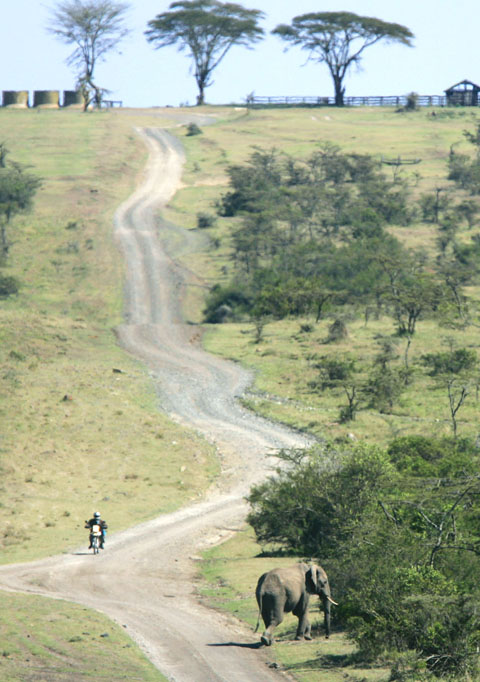The text message from the elephant flashed across Richard Lesowapir’s screen: Kimani was heading for neighboring farms.
The huge bull elephant had a long history of raiding villagers’ crops during the harvest, sometimes wiping out six months of income at a time. But this time a mobile phone card inserted in his collar sent rangers a text message. Lesowapir, an armed guard and a driver arrived in a jeep bristling with spotlights to frighten Kimani back into the Ol Pejeta conservancy.
Kenya is the first country to try elephant texting as a way to protect both a growing human population and the wild animals that now have less room to roam. Elephants are ranked as “near threatened” in the Red List, an index of vulnerable species published by the International Union for Conservation of Nature.

PHOTO: AP
The race to save Kimani began two years ago. The Kenya Wildlife Service had already reluctantly shot five elephants from the conservancy who refused to stop crop-raiding and Kimani was the last of the regular raiders. The Save the Elephants group wanted to see if he could break the habit.
So they placed a mobile phone SIM card in Kimani’s collar, then set up a virtual “geofence” using a global positioning system that mirrored the conservatory’s boundaries. Whenever Kimani approaches the virtual fence, his collar texts rangers.
They have intercepted Kimani 15 times since the project began.
Once almost a nightly raider, he last went near a farmer’s field four months ago.
It’s a huge relief to the small farmers who rely on their crops for food and cash for school fees. Basila Mwasu, a 31-year-old mother of two, lives a stone’s throw from the conservancy fence. She and her neighbors used to drum through the night on pots and pans in front of flaming bonfires to try to frighten the elephants away.
Once an elephant stuck its trunk through a window into a room where her baby daughter was sleeping and the family had stored some corn. She beat it back with a burning stick. Another time, an elephant killed a neighbor who was defending his crop.
“We had to go into town to tell the game [wardens] to chase the elephants away or we’re going to kill them all,” Mwasu said.
But the elephants kept coming back.
Batian Craig, the conservation and security manager at the 6,400 hectare Ol Pejeta conservancy, says community development programs are of little use if farmers don’t have crops.
He recalled the time when 15 families had their harvests wiped out.
“As soon as a farmer has lost his livelihood for six months, he doesn’t give a damn whether he has a school or a road or water or whatever,” he said.
Iain Douglas-Hamilton, founder of Save the Elephants, said the project is still in its infancy — so far only two geofences have been set up in Kenya — and it has its problems.
Collar batteries wear out every few years. Sometimes communities think placing a collar on an elephant implies ownership and responsibility for the havoc it causes. And it’s expensive work — Ol Pejeta has five full-time staff and a standby vehicle to respond when a message flashes across a ranger’s screen.
But the experiment with Kimani has been a success and Moses Litoroh, the coordinator of Kenya Wildlife Service’s elephant program, hopes the project might help resolve some of the 1,300 complaints the service receives every year over crop raiding.
Douglas-Hamilton says elephants, like teenagers, learn from each other, so tracking and controlling one habitual crop raider can make a whole group change its habits.

BACKLASH: The National Party quit its decades-long partnership with the Liberal Party after their election loss to center-left Labor, which won a historic third term Australia’s National Party has split from its conservative coalition partner of more than 60 years, the Liberal Party, citing policy differences over renewable energy and after a resounding loss at a national election this month. “Its time to have a break,” Nationals leader David Littleproud told reporters yesterday. The split shows the pressure on Australia’s conservative parties after Prime Minister Anthony Albanese’s center-left Labor party won a historic second term in the May 3 election, powered by a voter backlash against US President Donald Trump’s policies. Under the long-standing partnership in state and federal politics, the Liberal and National coalition had shared power

NO EXCUSES: Marcos said his administration was acting on voters’ demands, but an academic said the move was emotionally motivated after a poor midterm showing Philippine President Ferdinand Marcos Jr yesterday sought the resignation of all his Cabinet secretaries, in a move seen as an attempt to reset the political agenda and assert his authority over the second half of his single six-year term. The order came after the president’s allies failed to win a majority of Senate seats contested in the 12 polls on Monday last week, leaving Marcos facing a divided political and legislative landscape that could thwart his attempts to have an ally succeed him in 2028. “He’s talking to the people, trying to salvage whatever political capital he has left. I think it’s

CONTROVERSY: During the performance of Israel’s entrant Yuval Raphael’s song ‘New Day Will Rise,’ loud whistles were heard and two people tried to get on stage Austria’s JJ yesterday won the Eurovision Song Contest, with his operatic song Wasted Love triumphing at the world’s biggest live music television event. After votes from national juries around Europe and viewers from across the continent and beyond, JJ gave Austria its first victory since bearded drag performer Conchita Wurst’s 2014 triumph. After the nail-biting drama as the votes were revealed running into yesterday morning, Austria finished with 436 points, ahead of Israel — whose participation drew protests — on 357 and Estonia on 356. “Thank you to you, Europe, for making my dreams come true,” 24-year-old countertenor JJ, whose

Polish presidential candidates offered different visions of Poland and its relations with Ukraine in a televised debate ahead of next week’s run-off, which remains on a knife-edge. During a head-to-head debate lasting two hours, centrist Warsaw Mayor Rafal Trzaskowski, from Polish Prime Minister Donald Tusk’s governing pro-European coalition, faced the Eurosceptic historian Karol Nawrocki, backed by the right-wing populist Law and Justice party (PiS). The two candidates, who qualified for the second round after coming in the top two places in the first vote on Sunday last week, clashed over Poland’s relations with Ukraine, EU policy and the track records of their